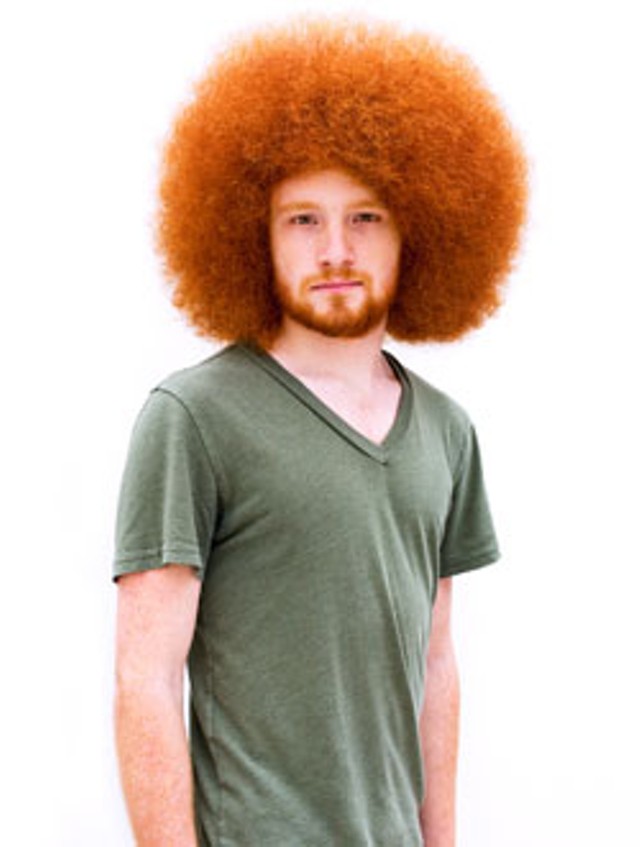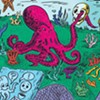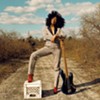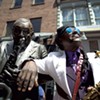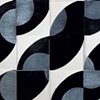Published April 20, 2011 at 9:02 a.m.
In 2007, media outlets the world over reported that redheads were going extinct, stating that by 2060, the flame-haired among us could cease to exist. While this theory was later debunked for its bad science and questionable research ethics, the claim sparked the interest of photographer Julia Baum.
The only red-haired person in her family, Baum set out to capture this tiny population (less than 2 percent of the world’s people) and create an archive of sorts for future generations on the off chance that those spurious predictions were right. The result is an ongoing photographic project called “A Rare Breed.” Selected images are currently on display at Green + Blue Gallery in Stowe.
Baum, 28, began her redhead portrait series two-and-a-half years ago. Since then, the Brooklyn-based photographer has made close to 40 portraits of this “special breed.” The project started as an examination of the hair itself, but has since evolved into something much deeper, she explains.
“Being a redhead affects who you are and where you see yourself in the world. Maybe it pushes people to be more extraordinary,” Baum suggests.
Red hair, a recessive trait, is a genetic mutation of the MC1R protein. Accordingly, having red hair makes you a curiosity, by turns an object of ridicule and desire.
It also means you will be stereotyped — redheaded women are seen as vixenish or witchlike; redheaded men are considered weak. Marion Roach writes in her book The Roots of Desire: The Myth, Meaning and Sexual Power of Red Hair, “That redheads are untrustworthy, fiery, unstable, hot-tempered, highly sexed, rare creatures is what passes for common knowledge today.”
At Seven Days, three staff members can boast (natural) red hair. Another was born a redhead, and though his hair is dusty auburn now, his beard remains a deep russet. We thought it appropriate to send two of those carrot-tops — music editor Dan Bolles and myself — to see Baum’s exhibit and examine it from a redhead’s perspective. While the reviews that follow are subjective, we promise them to be neither untrustworthy reportage nor highly sexed opinion.
I have always considered it a special thing to have red hair. Until my brother came along eight years after me, I was the sole redhead in my family. When I was a child, adults would fawn over me and ask where my hair came from.
During my primary-school years, I endured some teasing about my fiery locks, but the barbs hardly made an impact. I loved being a redhead. Pippi Longstocking and Anne of Green Gables were my red-haired heroes. They were whip-smart, obstinate girls who could always talk their way out of trouble. I strived to emulate them.
The older I got, the more I realized how differently redheads are often treated. No one would deign to ask anyone but a redhead such a prurient and tacky question as “Does the carpet match the drapes?” (The answer is always “yes,” so stop asking.)
Still, that is part of the redhead identity — being an anomaly, both genetically and aesthetically. It is through that prism that I viewed Baum’s exhibit.
A small, corridor-like room at the newly renovated gallery holds 11 photo portraits of redheads in white frames. Most subjects are your standard ginger — pale skin, light eyes, freckles. All are set against a white background, though none is lit from the same angle. Baum explains in a telephone interview that she shot all her subjects outside in natural light, then inserted the neutral background in postproduction. The reason for the effect is obvious: The hair color pops against the white.
There are doe-eyed Bianca, elfin January, frizz-haired Colby and rumpled Kevin, all staring out at us, asking us to take in more than what’s atop their heads. And I do. I see how much makeup the women wear to avoid looking spectral. I see the attitude that having red hair has allowed, or even forced, some of the subjects to adopt. And I see the quirkiness that is bred from difference. I may even smell some SPF 50.
In truth, the exhibit makes me feel jealous. I don’t have many freckles, and my hair, once a brilliant ruby hue, is now somewhere between golden red and strawberry blonde. Each of Baum’s subjects seems more authentically redheaded than I. Indeed, the portraits make me feel a bit wistful, especially that of young Claire, who, but for the freckle clusters littering her face, could have been me 25 years ago.
For non-redheads, Baum’s project is likely to be intriguing, if not slightly unsettling, given society’s often complicated relationship with red hair. For redheads, or rather for myself, her work celebrates how diverse and beautiful I know our tribe of gingers to be. And it reminds me just how much I want to remain a part of it.
—Lauren Ober
Growing up, being a redhead was simply something I tolerated. I learned to brush off the occasional schoolyard taunt. I would humor little old ladies who fawned over my ruddy tresses at church, while I, in turn, morbidly marveled at their azure coifs. In high school, I’d allow my pretty friend Emily to compare her dye job to my natural locks. (OK, I kinda enjoyed that last one.)
I never considered the color of my hair to be a defining quality, even though most people around me did. If only Robert Redford’s rubicund mop hadn’t faded to a sandy auburn by the time he filmed The Natural, perhaps I’d have found the strong, red-haired role model I needed. (My other options: Archie, Ron Howard and the Hamburglar. Ginga, please.)
As I’ve grown older, I’ve embraced the aesthetic quality that sets me apart from 99 percent of the world’s population. I don’t mind that strangers address me as “Red.” I get a kick out of being stopped on the street by someone taken with my color. And, yes, that happens. I even helped found a rock band, the Ginger Snaps, whose sole requirement for membership was to carry the MC1R gene. By the way, wouldn’t MC One-R be a great name for a redheaded rapper?
What is striking about Baum’s project, and even more pronounced in the additional portraits on her blog, is that you can see a similar evolution of ginger identity in the faces of her subjects. Cherub-like infant Erin projects wide-eyed innocence — perhaps because she has no idea what she’s in for. Claudia exudes impish, preteen charm, while the precocious Johanna glowers with steely but inquisitive “tween” ’tude. Ben boasts a mischievous snarl below his schoolboy crew cut. Teenaged Joseph defiantly stares down the camera.
Granted, those qualities are not unique to ginger kids. Most teens are defiant, right? But among Baum’s older subjects, the effects of growing up red come more clearly into focus and, in many cases, hold true to stereotypes — for example, about our fiery temperament.
I wouldn’t cross a testy Leslie, the sassy iO, or the severe, inked-up Marisa. That goes double for the last, given redheads’ notoriously low tolerance for pain. Clearly, Marisa is a badass.
Several of Baum’s female subjects radiate a steamy, raw sensuality that lends some credence to Marion Roach’s thesis regarding the visceral allure of red hair — at least where women are concerned.
A few of Baum’s male subjects fortify the notion of the redheaded man as a nebbish milquetoast, perhaps battered into submission by a lifetime of teasing — or avoiding sunlight. Others, thankfully, boast a more robust, Redford-esque appeal. Still others legitimize the lighter, devilish perception of redheads. Nick could be Conan O’Brien’s mustachioed cousin, while Drew’s spherical ’fro rivals that of the Roots’ ?uestlove.
Baum’s project is more than an exposition of pale skin, freckles and wild hair. For redheads, the singularity that sets us apart also binds us together, not merely in appearance but in shared life experiences. As Baum shows us, that makes redheads a very rare breed, indeed.
—Dan Bolles
Info
“A Rare Breed,” photographic portraits of redheads by Julia Baum. Green + Blue Gallery, Stowe. Through May 8.
More By This Author
Speaking of Art,
-

Morrisville Sculptor Thea Alvin Is Recognized With $100,000 Craft Award
May 22, 2024 -

Q&A: Catching Up With the Champlain Valley Quilt Guild
Apr 10, 2024 -

Video: The Champlain Valley Quilt Guild Prepares for Its Biennial Quilt Show
Apr 4, 2024 -

Q&A: Meet a Family in Waterbury That Embraces Halloween Year-Round
Feb 14, 2024 -

Video: Goth Family in Waterbury: Sarah, Jay and Zarek Vogelsang-Card
Feb 8, 2024 - More »
Comments
Comments are closed.
From 2014-2020, Seven Days allowed readers to comment on all stories posted on our website. While we've appreciated the suggestions and insights, right now Seven Days is prioritizing our core mission — producing high-quality, responsible local journalism — over moderating online debates between readers.
To criticize, correct or praise our reporting, please send us a letter to the editor or send us a tip. We’ll check it out and report the results.
Online comments may return when we have better tech tools for managing them. Thanks for reading.
































